Radishrain
Things pertaining to life: plants and animals, gardening, cooking, food, botany, zoology, farming, ranching, wildlife, genetics, plant breeding, software, media, etc.
Based off of things I've read (I do a lot of tomato research), and some things I've grown, I'm going to make a list of particularly notable tomato varieties here. I've only tried some of these. They're not all my personal favorites, but in my opinion, they're all notable, and if you grow them all I'm sure you'll be enriched.
Note that if I say 'see also', I don't necessarily mean that there's a genetic relationship between those two tomatoes, but rather that I think those ones may also be of interest. If it starts with a question mark that means I suspect it belongs in this list, but I'm not 100% sure.
If I put an exclamation mark before it, that means I personally think it belongs here, but that few to no other people that I know of particularly do. Two exclamations means other people think it belongs here, but from my experience, I don't particularly agree.
Tomatoes make it to this list due to one or more of several factors:
• Unusually good taste
• Production / vigor
• Popularity
• Hardiness
• Other notable qualities
• Amana Orange (Burrough's Strain; see also the regular Amana Orange, and Chef's Choice Orange F1)
• ?Ambrosia Red
• Amish Paste
• !!Aunt Gertie's Gold
• Aunt Ginny's Purple
• !!Azoychka
• Bear Creek
• Better Boy F1
• Black Beauty
• Black Cherry (see also Austin's Black Cherry)
• Black from Tula
• Black Krim (see also Noir de Crimee')
• !!Black Prince
• ?Black Sea Man
• Bloody Butcher (also see Mat-Su Express)
• Blush
• Box Car Willie
• Brandy Boy F1
• Brandywine (Sudduth's, OTV, Cowlick's, Yellow, Black, True Black, Red; also similar types like Caspian Pink)
• Camp Joy
• Carbon
• Celebrity F1
• Cherokee Purple (also see some other Cherokee types: Cherokee Chocolate, Cherokee Green, and Cherokee Lime)
• Chocolate Cherry
• Chocolate Sprinkles F1
• Crimson Cushion (AKA Beefsteak)
• Cuostralee (see also Pink Cuostralee)
• Dester
• Domingo
• Dr. Wyche's Yellow (see also Sweet Ozark Orange)
• Druzba
• Early Girl F1
• EM Champion
• !Galapagos Island (S. cheesmaniae; the early, yellow, round cherry)
• German Johnson
• Girl Girl's Weird Thing
• Gold Medal
• Green Doctors (also see Green Doctors Frosted, Dr. Carolyn, Dr. Carolyn Pink, and Galinas)
• Green Tiger (also see Maglia Rosa and Pink Tiger)
• !!Green Zebra
• Hillbilly PL
• Indian Stripe PL (see also Indian Stripe / !!Indian Zebra, and Cherokee Purple)
• Italian Heirloom
• J.D.'s Special C-Tex
• Jagodka
• Japanese Black Trifele
• Jaune Flammee
• ?Jim Dandy
• Juliet F1 (see also Jujube)
• KBX (see also Kellogg's Breakfast and Kellogg's Beefsteak)
• Malakhitovaya Shkatulka (see also Aunt Ruby's German Green, Green Giant, Grubb's Mystery Green, Hugh's, Cherokee Green, Cherokee Lime, etc.)
• !!Marianna's Peace
• !Marion (see also Homestead and Rutgers)
• Marzano Fire
• Mountain Princess
• !Napoli
• Opalka
• Orange Jazz (see also Jazz)
• !Ovita
• Pale Perfect Purple
• Pantano Romanesco
• Paul Robeson
• Persimmon
• !!Pineapple
• Pink Berkeley Tie Dye (see also Berkeley Tie Dye)
• Pink Oxheart
• Polish Linguisa
• Pruden's Purple (see also Vorlon)
• Rebel Yell
• Roma (also see VF Roma)
• Rutgers (see also Rutgers 250, Rutgers Schermerhorn 250, and Marion)
• Sausage
• !Sheboygan
• Stump of the World
• SunGold F1 (see also SunSugar F1, SunOrange F1, etc.)
• Super Snow White
• Sweet Cherriette
• Terhune
• Thessaloniki (see also Creole)
• Thessaloniki Ox Heart (AKA Thessie O; Note that 'Ox Heart' is the correct spelling in the variety name, even though oxheart is the correct spelling for the shape of this tomato.)
Note that if I say 'see also', I don't necessarily mean that there's a genetic relationship between those two tomatoes, but rather that I think those ones may also be of interest. If it starts with a question mark that means I suspect it belongs in this list, but I'm not 100% sure.
If I put an exclamation mark before it, that means I personally think it belongs here, but that few to no other people that I know of particularly do. Two exclamations means other people think it belongs here, but from my experience, I don't particularly agree.
Tomatoes make it to this list due to one or more of several factors:
• Unusually good taste
• Production / vigor
• Popularity
• Hardiness
• Other notable qualities
• Amana Orange (Burrough's Strain; see also the regular Amana Orange, and Chef's Choice Orange F1)
• ?Ambrosia Red
• Amish Paste
• !!Aunt Gertie's Gold
• Aunt Ginny's Purple
• !!Azoychka
• Bear Creek
• Better Boy F1
• Black Beauty
• Black Cherry (see also Austin's Black Cherry)
• Black from Tula
• Black Krim (see also Noir de Crimee')
• !!Black Prince
• ?Black Sea Man
• Bloody Butcher (also see Mat-Su Express)
• Blush
• Box Car Willie
• Brandy Boy F1
• Brandywine (Sudduth's, OTV, Cowlick's, Yellow, Black, True Black, Red; also similar types like Caspian Pink)
• Camp Joy
• Carbon
• Celebrity F1
• Cherokee Purple (also see some other Cherokee types: Cherokee Chocolate, Cherokee Green, and Cherokee Lime)
• Chocolate Cherry
• Chocolate Sprinkles F1
• Crimson Cushion (AKA Beefsteak)
• Cuostralee (see also Pink Cuostralee)
• Dester
• Domingo
• Dr. Wyche's Yellow (see also Sweet Ozark Orange)
• Druzba
• Early Girl F1
• EM Champion
• !Galapagos Island (S. cheesmaniae; the early, yellow, round cherry)
• German Johnson
• Girl Girl's Weird Thing
• Gold Medal
• Green Doctors (also see Green Doctors Frosted, Dr. Carolyn, Dr. Carolyn Pink, and Galinas)
• Green Tiger (also see Maglia Rosa and Pink Tiger)
• !!Green Zebra
• Hillbilly PL
• Indian Stripe PL (see also Indian Stripe / !!Indian Zebra, and Cherokee Purple)
• Italian Heirloom
• J.D.'s Special C-Tex
• Jagodka
• Japanese Black Trifele
• Jaune Flammee
• ?Jim Dandy
• Juliet F1 (see also Jujube)
• KBX (see also Kellogg's Breakfast and Kellogg's Beefsteak)
• Malakhitovaya Shkatulka (see also Aunt Ruby's German Green, Green Giant, Grubb's Mystery Green, Hugh's, Cherokee Green, Cherokee Lime, etc.)
• !!Marianna's Peace
• !Marion (see also Homestead and Rutgers)
• Marzano Fire
• Mountain Princess
• !Napoli
• Opalka
• Orange Jazz (see also Jazz)
• !Ovita
• Pale Perfect Purple
• Pantano Romanesco
• Paul Robeson
• Persimmon
• !!Pineapple
• Pink Berkeley Tie Dye (see also Berkeley Tie Dye)
• Pink Oxheart
• Polish Linguisa
• Pruden's Purple (see also Vorlon)
• Rebel Yell
• Roma (also see VF Roma)
• Rutgers (see also Rutgers 250, Rutgers Schermerhorn 250, and Marion)
• Sausage
• !Sheboygan
• Stump of the World
• SunGold F1 (see also SunSugar F1, SunOrange F1, etc.)
• Super Snow White
• Sweet Cherriette
• Terhune
• Thessaloniki (see also Creole)
• Thessaloniki Ox Heart (AKA Thessie O; Note that 'Ox Heart' is the correct spelling in the variety name, even though oxheart is the correct spelling for the shape of this tomato.)
This question on BYU's 100 Hour Board is one I've probably thought about before, and the answer is great, IMO: http://100hourboard.org/questions/22782/
salt_
salt_
I put what I think are some Aunt Molly's ground cherries (from a volunteer plant) in some spots so they would volunteer there next year. It might be crossed with other ground cherries. It got bigger and tastier fruits than the Ammon Martin's and Rachel's Favorite ground cherries that I started from seed and transplanted, this year. They had black plastic and eastern shade, but Aunt Molly's had shredded wood mulch, and I guess it had some eastern shade, due to the grapevine.
We've had Aunt Molly's ground cherries growing on the property for a few years now. It's a good variety. However, I preferred the taste of Ammon Martin's and Goldie the first year I grew those (which was the second year I grew Aunt Molly's).
Aunt Molly's is a good variety, similar to Goldie and Ammon Martin's.
We've had Aunt Molly's ground cherries growing on the property for a few years now. It's a good variety. However, I preferred the taste of Ammon Martin's and Goldie the first year I grew those (which was the second year I grew Aunt Molly's).
Aunt Molly's is a good variety, similar to Goldie and Ammon Martin's.
I first grew the King Winter watermelon in 2016, watered well without black plastic or any kind of mulch. It got a fair amount of small-ish fruits, with dull skin. the taste was like watermelon Jolly Ranchers. The seeds were black. I grew it again in 2017, with drought conditions, unmulched, without black plastic, with similar results. I didn't grow it in 2018. This year (2019), I grew it with black plastic with western shade. I grew seeds saved in 2017, and seeds from the original seed packet, this year. The rind has more prominent stripes than Navajo Winter. In 2016 and 2017, the rind was almost white.
The rinds look glossier/waxier and greener, this year, for fruits from both seed sources, which makes me think maybe warmer soil helps the rinds to be glossier.
I just opened a fruit (from seed from the original seed packet) and ate it. It was over-ripe and not surprisingly, didn't have the watermelon Jolly Rancher taste. The center was mushy and on the sides was firm. The seeds look larger, this year, but are black as usual. A lot of seeds were stuck together (but I separated them in my mouth).
Here are pictures of it:
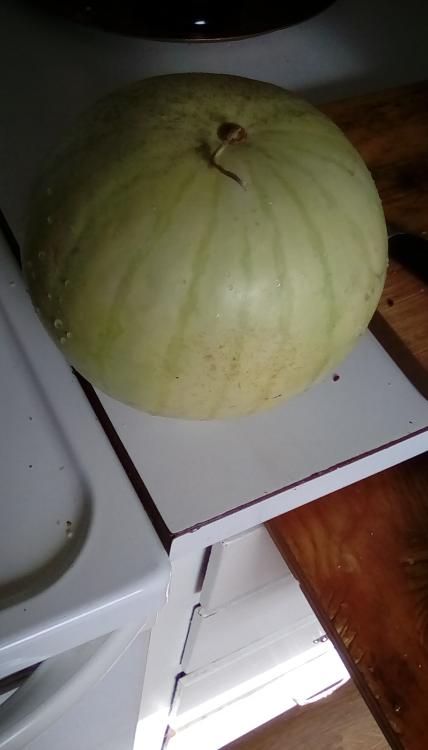
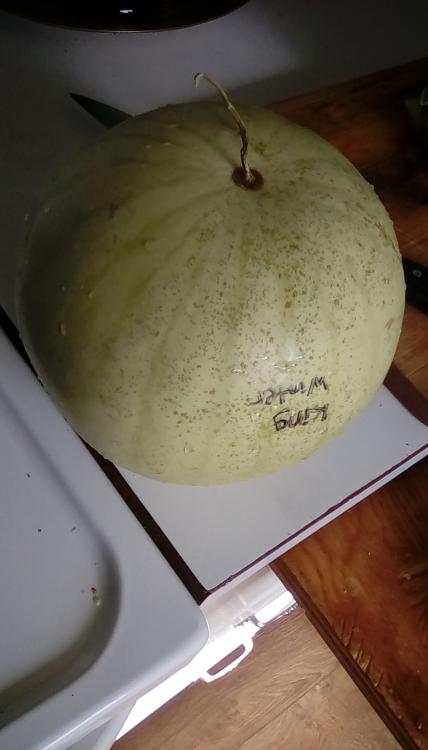
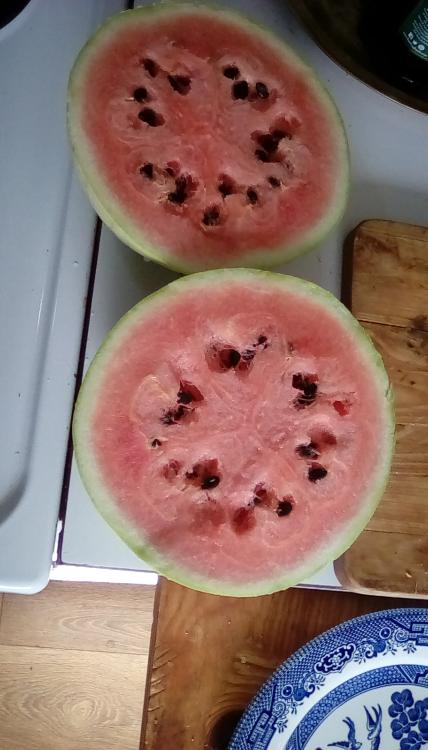
This is a large spoon (I prefer regular spoons, but large spoons are the only available ones …):
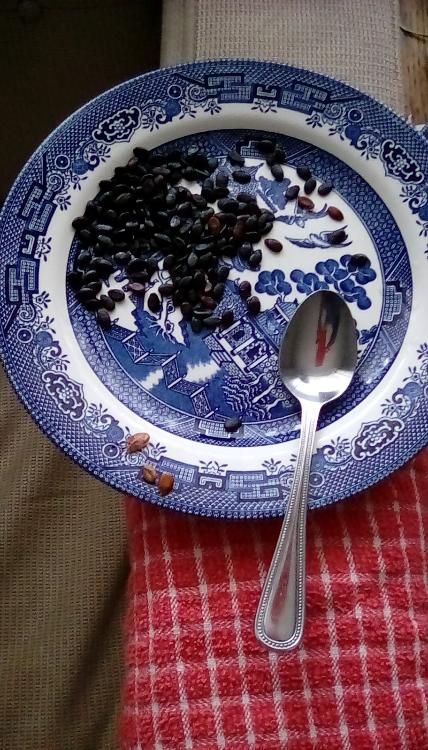
The rinds look glossier/waxier and greener, this year, for fruits from both seed sources, which makes me think maybe warmer soil helps the rinds to be glossier.
I just opened a fruit (from seed from the original seed packet) and ate it. It was over-ripe and not surprisingly, didn't have the watermelon Jolly Rancher taste. The center was mushy and on the sides was firm. The seeds look larger, this year, but are black as usual. A lot of seeds were stuck together (but I separated them in my mouth).
Here are pictures of it:



This is a large spoon (I prefer regular spoons, but large spoons are the only available ones …):

Here's the first Navajo Winter watermelon that I've eaten, this year. It has a very thick rind (so it's probably a cross). Nevertheless, most of the rind is sweet and approximately the same texture as the inner fruit. It still has winter watermelon skin (in toughness). It tasted great! It was quite sweet and good. I definitely want to grow the seeds. The seeds were a pearlescent black (shinier than other black seeds I've saved before).
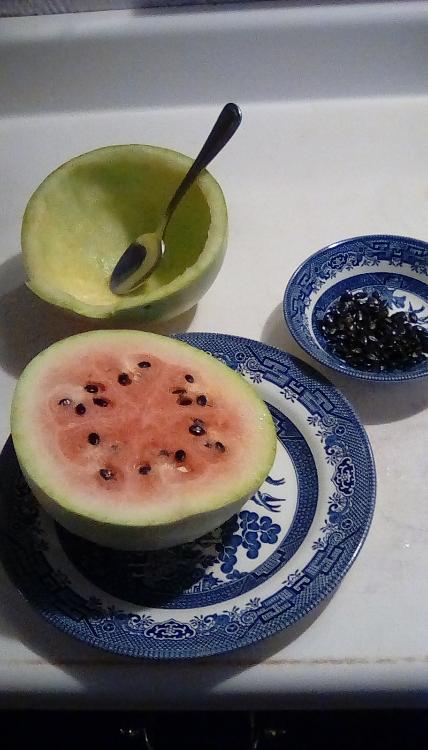
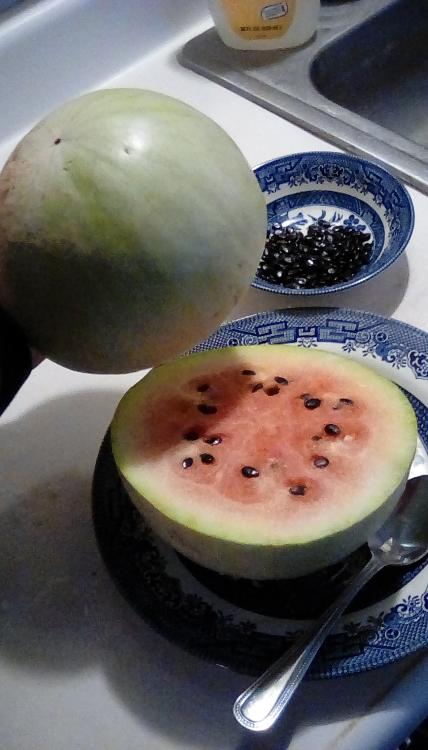
Notice how much of the rind I ate (what's left is the harder, non-sweet part of the rind):
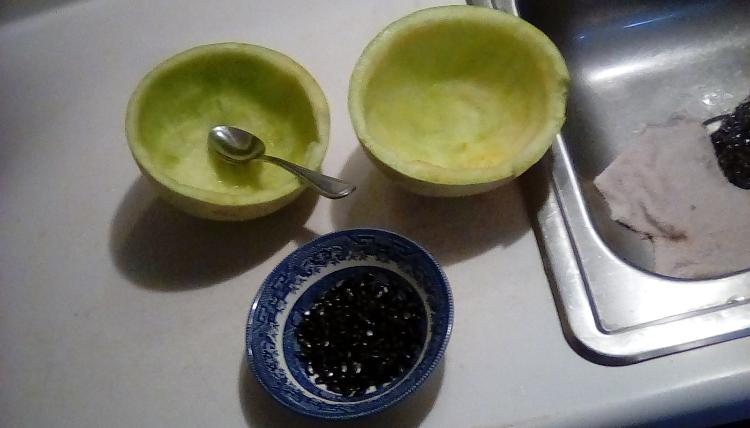


Notice how much of the rind I ate (what's left is the harder, non-sweet part of the rind):

Although the Endless Summer tomato (a genetically engineered one from a really long time ago) doesn't appear to have had success in grocery stores, it appears that Burpee has an Endless Summer tomato that remarkably has a similar shelf-life description (except it lasts even longer!) It's said to be available at the Home Depot (but not shipped to your house).
Are these the same tomato? Are they related? I don't know, but I think we need need some additional labeling here if it is, or a different tomato name if not.
Here's a thread I started on another forum, off-site, asking if anyone knew about it.
Well, at least any patents on it are likely to have expired. So, if GMO tomatoes contaminate other tomatoes at least they won't make the new hybrids illegal. Plus, it should be easy to tell if your tomato has the modified trait, since they might not ripen. But yeah, some people won't want to grow tomatoes descended from GMO tomatoes even if they lack the gene of their ancestor (I'm not excited about the prospect, myself).
Are these the same tomato? Are they related? I don't know, but I think we need need some additional labeling here if it is, or a different tomato name if not.
Here's a thread I started on another forum, off-site, asking if anyone knew about it.
Well, at least any patents on it are likely to have expired. So, if GMO tomatoes contaminate other tomatoes at least they won't make the new hybrids illegal. Plus, it should be easy to tell if your tomato has the modified trait, since they might not ripen. But yeah, some people won't want to grow tomatoes descended from GMO tomatoes even if they lack the gene of their ancestor (I'm not excited about the prospect, myself).
This thread is a continuation of a thread on the old forum, which I thought had a lot more information about what I've done in it (maybe I posted that on other forums).
Today, I transplanted the rest of my seed-grown domestic strawberries, just south of where I transplanted Tresca earlier. I didn't split up any plants. I want to focus more on saving seeds for another generation from the first fruits, since the plants are diseased. I can try zapping the fruits next year to see if that removes the disease from the seeds. I can try zapping Reine des Vallees's fruits this year, though (it has some already); yes, it caught the disease, too. Anyway, the Quinault parent plant seems the most disease-resistant out of all my strawberries.
If up is east, and down is west, here's the order they're in:
* Tresca (previously transplanted)
* Fresca
* Ozark Beauty
* Quinault
Of course, Ozark Beauty and Quinault shouldn't be true-to-type, since they're seed-grown here, and they're octoploids. So, I'm very curious how they'll perform.
I don't know how Tresca and Fresca are supposed to be true-to-type domestoc strawberries, since they're supposed to be octoploids, too, as far as anyone seems to know. Stabilizing a tetraploid is no small task (if it even happens), let alone an octoploid!
Okay, so tomatoes, which are easily bred, are diploids. That means they have two sets of chromosomes. So, they have genes with two alleles per gene. So, for their leaf type, there are regular leaf alleles and potato leaf alleles, among others. Potato leaf is recessive to regular leaf. In order to stabilize that one tomato trait (there are many other traits to stabilize), if you want a regular leaf plant, you need to do some serious breeding to ensure that there are no potato leaf alleles. If you want pitato leaf plants, you just need to find a child plant with potato leaf leaves (since both alleles have to be potato leaf in order to be expressed).
Anyway, with domestic strawberries they have eight alleles per gene. Imagine how much harder it's going to be to get all eight alleles to be the same, especially for dominant traits. Fortunately, you can grow genetically identical strawberries without stabilizing them. Just grow the runners, if you want then to be the same.
This is my first time transplanting strawberries after it's already been freezing. So, I'm excited to see what happens and how well they weather the winter. I figure they need the vigor that overwintering often provides, and they're cold hardy. So, why not transplant in the cold, too. Hopefully the winter will kill the disease.
If you're wondering what happened to my Tristar strawberry seeds that I planted, they were next to heavily diseased plants (the runners that I rooted indoors). So, I threw them out before they sprouted. I thought I posted about Tristar on the old site, but I don't see anything of the kind there.
Anyway, to avoid disease indoors, I should have done this, I suppose:
* Zapped all the fruits before I planted them
* Not brought strawberry runners indoors
* Not misted my plants
For the outdoor plants, I oughtn't to have planted tomatoes near the strawberries either, let alone in the middle of the strawberry patch. I also shouldn't have accepted the Ozark Beauty strawberries that I was gifted (but rather just some fruits, and have zapped them; although I didn't know the need to do that then). The soil was also likely too salty (my hypothesis for the reason is cats using it as a litter box) and potentially too compact.
Anyway, even if strawberries have this disease, I can probably still grow out more generations, and probably still get fruit.
Well, this is a chance to work on breeding disease-resistant strawberries! I'm guessing if zapping removes the diseases, then repeated grow-outs from exposed generations of plants may eventually help future generations to gain immunity through acclimatization.
I'm also tempted to zap some plants (in water) to see if it removes the disease.
Today, I transplanted the rest of my seed-grown domestic strawberries, just south of where I transplanted Tresca earlier. I didn't split up any plants. I want to focus more on saving seeds for another generation from the first fruits, since the plants are diseased. I can try zapping the fruits next year to see if that removes the disease from the seeds. I can try zapping Reine des Vallees's fruits this year, though (it has some already); yes, it caught the disease, too. Anyway, the Quinault parent plant seems the most disease-resistant out of all my strawberries.
If up is east, and down is west, here's the order they're in:
* Tresca (previously transplanted)
* Fresca
* Ozark Beauty
* Quinault
Of course, Ozark Beauty and Quinault shouldn't be true-to-type, since they're seed-grown here, and they're octoploids. So, I'm very curious how they'll perform.
I don't know how Tresca and Fresca are supposed to be true-to-type domestoc strawberries, since they're supposed to be octoploids, too, as far as anyone seems to know. Stabilizing a tetraploid is no small task (if it even happens), let alone an octoploid!
Okay, so tomatoes, which are easily bred, are diploids. That means they have two sets of chromosomes. So, they have genes with two alleles per gene. So, for their leaf type, there are regular leaf alleles and potato leaf alleles, among others. Potato leaf is recessive to regular leaf. In order to stabilize that one tomato trait (there are many other traits to stabilize), if you want a regular leaf plant, you need to do some serious breeding to ensure that there are no potato leaf alleles. If you want pitato leaf plants, you just need to find a child plant with potato leaf leaves (since both alleles have to be potato leaf in order to be expressed).
Anyway, with domestic strawberries they have eight alleles per gene. Imagine how much harder it's going to be to get all eight alleles to be the same, especially for dominant traits. Fortunately, you can grow genetically identical strawberries without stabilizing them. Just grow the runners, if you want then to be the same.
This is my first time transplanting strawberries after it's already been freezing. So, I'm excited to see what happens and how well they weather the winter. I figure they need the vigor that overwintering often provides, and they're cold hardy. So, why not transplant in the cold, too. Hopefully the winter will kill the disease.
If you're wondering what happened to my Tristar strawberry seeds that I planted, they were next to heavily diseased plants (the runners that I rooted indoors). So, I threw them out before they sprouted. I thought I posted about Tristar on the old site, but I don't see anything of the kind there.
Anyway, to avoid disease indoors, I should have done this, I suppose:
* Zapped all the fruits before I planted them
* Not brought strawberry runners indoors
* Not misted my plants
For the outdoor plants, I oughtn't to have planted tomatoes near the strawberries either, let alone in the middle of the strawberry patch. I also shouldn't have accepted the Ozark Beauty strawberries that I was gifted (but rather just some fruits, and have zapped them; although I didn't know the need to do that then). The soil was also likely too salty (my hypothesis for the reason is cats using it as a litter box) and potentially too compact.
Anyway, even if strawberries have this disease, I can probably still grow out more generations, and probably still get fruit.
Well, this is a chance to work on breeding disease-resistant strawberries! I'm guessing if zapping removes the diseases, then repeated grow-outs from exposed generations of plants may eventually help future generations to gain immunity through acclimatization.
I'm also tempted to zap some plants (in water) to see if it removes the disease.
Some people think wonderberries are black nightshade, such as is seen on one of the posts in the following thread on another forum: https://www.homesteadingtoday.com/threads/anyone-ever-grow-wonderberry-plants.298177/
However, I've never found any evidence that they are black nightshade, other than a similar appearance. Chichiquelite is also similar to black nightshade (but it's another species, too). Otricoli Orange Berry is black nightshade (but it's an orange kind of it). Wonderberries are listed as a separate species (and I think they're a hybrid species). I've grown all three. Wonderberries slip more easily from their calyxes, and in my opinion taste better. The others tasted toxic to me, however; see these posts I made about them:
* http://vegetables.boards.net/thread/136/ripe-chichiquelite
* http://vegetables.boards.net/thread/135/ripe-otricoli-orange-berries
Whatever the case, having eaten wonderberries, I can say with confidence that they the ripe ones are quite edible.
Also note that people in that thread say wonderberry leaves are edible. Huh? From what I've read elsewhere you definitely don't want to eat them for food. I wouldn't eat them, even though some people eat the leaves of edible black nightshades. They're a different species.
Wonderberry = Solanum retroflexum
Black Nightshade and Otricoli Orange Berry = Solanum nigrum
Chichiquelite and Garden Huckleberry = Solanum melanocerasum
Nevertheless some people think they're the same still. I doubt it, however.
Wonderberries are the easiest of those species to grow in my garden by far.
Note that my wonderberries are never particularly shiny pre-harvest. Chichiquelite is shiny, though.
However, I've never found any evidence that they are black nightshade, other than a similar appearance. Chichiquelite is also similar to black nightshade (but it's another species, too). Otricoli Orange Berry is black nightshade (but it's an orange kind of it). Wonderberries are listed as a separate species (and I think they're a hybrid species). I've grown all three. Wonderberries slip more easily from their calyxes, and in my opinion taste better. The others tasted toxic to me, however; see these posts I made about them:
* http://vegetables.boards.net/thread/136/ripe-chichiquelite
* http://vegetables.boards.net/thread/135/ripe-otricoli-orange-berries
Whatever the case, having eaten wonderberries, I can say with confidence that they the ripe ones are quite edible.
Also note that people in that thread say wonderberry leaves are edible. Huh? From what I've read elsewhere you definitely don't want to eat them for food. I wouldn't eat them, even though some people eat the leaves of edible black nightshades. They're a different species.
Wonderberry = Solanum retroflexum
Black Nightshade and Otricoli Orange Berry = Solanum nigrum
Chichiquelite and Garden Huckleberry = Solanum melanocerasum
Nevertheless some people think they're the same still. I doubt it, however.
Wonderberries are the easiest of those species to grow in my garden by far.
Note that my wonderberries are never particularly shiny pre-harvest. Chichiquelite is shiny, though.
So, I was curious what kind of worms we have in our blackberries when they get extra ripe. I found this article. I'm not sure if they're the same worms, but I wouldn't be surprised. I found one of the blackberry worms (or so it appeared) in a wonderberry, too.
https://www.kuow.org/stories/there-are-worms-blackberries-you-just-picked
The article talks about a fruit fly that deposits eggs in berries (especially blackberries) and how it recently colonized all of North America. The worms are said to be edible, but I don't know of any scientific studies supporting it. I'm sure I've eaten them unknowingly and survived, though.
EDIT: After looking at the pictures of the worms and photos, I don't think these are the same things I've seen in our blackberries. The ones in our berries seemed to have been larger, whiter, and were always wet with the berry juice (I never saw them on the outside).
worm_
blackberry_
wonderberry_
https://www.kuow.org/stories/there-are-worms-blackberries-you-just-picked
The article talks about a fruit fly that deposits eggs in berries (especially blackberries) and how it recently colonized all of North America. The worms are said to be edible, but I don't know of any scientific studies supporting it. I'm sure I've eaten them unknowingly and survived, though.
EDIT: After looking at the pictures of the worms and photos, I don't think these are the same things I've seen in our blackberries. The ones in our berries seemed to have been larger, whiter, and were always wet with the berry juice (I never saw them on the outside).
worm_
blackberry_
wonderberry_
Subscribe via email
Archives
| Free forum by Nabble | Edit this page |


